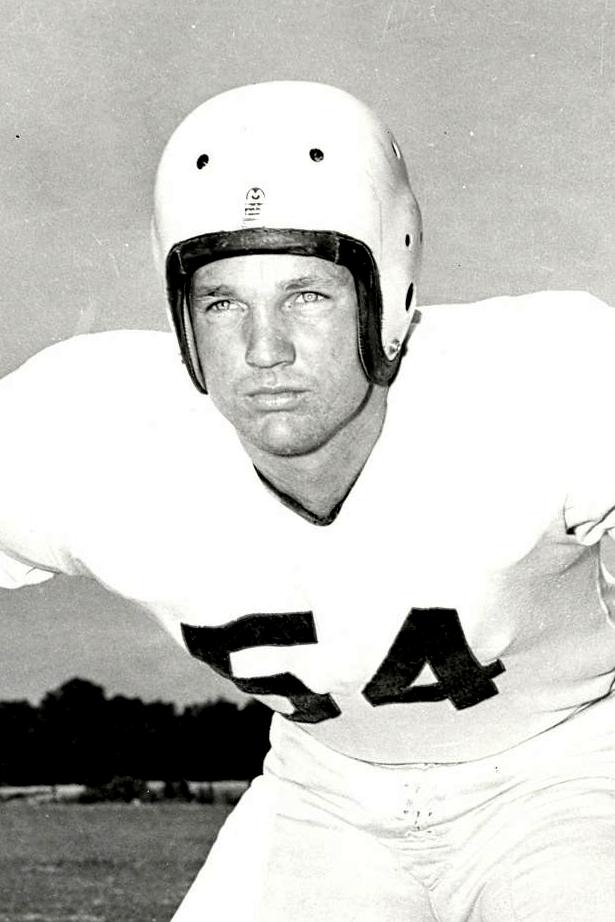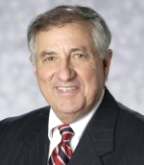Hugh Adams, Little All-American
By Jim Joanos
 |
In 1947, the Florida State College for Women, an all-women’s college, was changed into a coeducational institution, as it had been for years through the school year, 1904-05. It’s name became “Florida State University”. Immediately, thereafter the school instituted a men’s intercollegiate athletics program including football. FSU football has attained lots of success and honors through the years. Included in those honors achieved has been a long list of players who attained either Little All-American or All-American national recognition for their play. This article is about the first player on that list. Hugh Adams was designated a Little All-American after both the 1948 and 1949 seasons.
After a lifetime of high achievement, Adams died in 2010. During his professional life he had been Superintendent of Schools for Florida’s Charlotte County, President of Broward College for 19 years, Executive Director of the Broward Center for Performing Arts, and President of the Broward Performing Arts Foundation. He had served on numerous state, national and even international projects and commissions regarding education. During his lifetime he had been recognized and honored by being awarded numerous honors and awards. He served on several commissions involving national and even international education. A Navy military veteran, he had served both on active duty as well as in the reserves and had attained the rank of Commander. A community leader of the highest category he had also served in numerous volunteer positions. In summary, the FSU alum had lived a very full and outstanding life as a prominent citizen.
Adams came to FSU in 1948, the first year of Don Veller’s tenure as FSU’s head coach. Adams already had some academic credit. He immediately became a leader on the football team. He was a tackle that played both on offense and defense as was the custom at that time. Although it was only the second year that FSU had reinstituted football, it quickly became a powerhouse among the small colleges in the southeast. The two years that Adams played for FSU the team records were 7-1 and 9-1. In those years, FSU belonged to an athletic conference of small schools named the “Dixie” Conference in which it played four conference games each year. The Seminoles were undefeated in the conference going 4-0 both years and winning the conference championships. Adams was Captain and Most Valuable player of the 1949 team which was the first in FSU history to play as well as to win a bowl game, the Cigar Bowl in Tampa. FSU beat Wofford College, 19-6. Adams’ play was exemplary. Both years that he played for FSU, he was honored by being proclaimed at the end of the season as a Little All-American. In 1980, Adams’ accomplishments as a football player were recognized by induction into the FSU Athletics Hall of Fame.
Adams attained his bachelor’s degree and began work on a master’s. For the school year, 1950-51, Adams, was also employed at Leon High School in Tallahassee. In addition to teaching, he served as an assistant football coach and as head coach of the Leon Track Team. I was fortunate to have been a member of both teams as an eleventh grader. Coach Adams was immediately accepted by the Leon faculty as well as by the athletes. He worked long hours and he was very innovative and intelligent but humble. He took a personal interest in each player that he coached as well as each student that he taught. In football, although he coached linemen and I was a reserve back, I felt his positive effect upon the team. He became a major influence in our lives.
One of the major things that I remember Coach Adams doing was to change the way we lined up on defense. Before he came to Leon, like most high school teams, our defense would line up in the same formation each play regardless of the down or distance needed by the opposing team for a first down. In 1950, Coach Adams assisted Leon in instituting a defensive scheme more akin to college systems. Under the new system, dependent upon down and distance, Leon’s defense would line up in one of three formations. It was a big improvement.
I had more direct contact with Adams in track rather than football. Coach did not have previous involvement with track and field. First, he had to learn about the different events and how to train for them. He acquired a book on track and field and studied it. He became quite knowledgeable about the sport and assisted us in improving our abilities. Track had not been a big deal at Leon before Coach Adams came. If you were not good in baseball, you might go out for track. He gave the track team more pride. He increased the attention and made arrangements for us to travel to some of the special events around the state like the Hillsborough Relays in Tampa and the Florida Relays in Gainesville. Somehow, he got the school’s administration to end school at lunchtime one Friday so that the student body could attend a special track meet at Leon where a number of teams competed. To this day, I vividly remember that day and the excitement we had. Coach Adams also took charge of maintaining the track. It was not much of a facility. It was mostly clay. When it rained it would become muddy and lumpy. Coach Adams would borrow a truck and a wooden drag contraption and drive around the track smoothing it back into some semblance of satisfaction. He would do this on weekends and other times when we did not have meets. Some of the members of the team would help. It was fun. In many ways Coach Adams improved the spirit and status of that team. He was a role model of the highest order and made those around him better people.
Coach Adams loved football. Something that occurred that spring made that clear. Although he had exhausted his eligibility to play college football he volunteered and played as a backup linesman in FSU’s spring game. FSU was somewhat short of linemen. Adams could have been injured but that apparently took second place to his desire to play some more. In later discussing the experience, he said that he had enjoyed the physical experience immensely.
He attained his bachelor’s degree that spring but stayed at FSU. In the next few years, he continued to get a master’s and then a Ph.D. making it three degrees from FSU. Also employed by FSU during that time, he first served as an assistant football coach and then as assistant dean of men. After such an exemplary time at FSU, Dr. Adams went back to Punta Gorda, Florida, to where he had grown up. In time, Hugh Adams, the first FSU football player that gained national recognition became an educator of national recognition. He was an example of the best in college athletics. I am fortunate to have known him. We are fortunate that he played football at Florida State University.
About the author:
 |
Jim Joanos |
Memories of Garnet and Gold
Jim Joanos and his wife Betty Lou have deep roots at Florida State University. Avid sports fans, they have literally seen, and done, it all. Fortunately for us, Jim loves telling first-hand accounts dating back to FSU’s first football game, a 1947 clash with the Stetson Hatters on Centennial Field, where Cascades Park is today.
The Osceola will run a series of these colorful stories written by the former Tallahassee lawyer and judge, which we feel our readers will find enlightening and/or nostalgic.
Jim and Betty Lou, who was Associate Director of the FSU Alumni Association (1991-2003), have been married 65 years and are each listed as one of FSU’s 100 Distinguished Graduates. The couple were enshrined in the FSU Hall of Fame in 2015 as Moore-Stone Award Recipients. Ironically, both Deans Moore and Stone were instrumental in the Joanoses career development.
“Both Jim and Betty Lou Joanos have been exemplary fans and supporters of Florida State University, both academically and athletically,” said Andy Miller, retired President and CEO of Seminole Boosters, Inc. “You can’t go to an athletic event of any kind that you don’t see both Jim and Betty Lou Joanos together. They love their university as much as they love each other.”